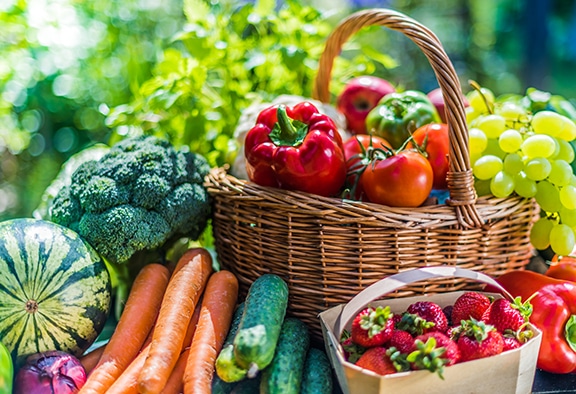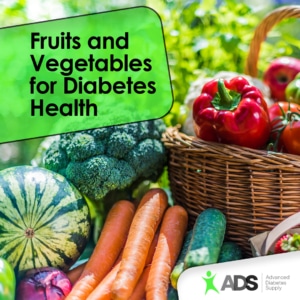
Fruits and vegetables are an indispensable element of any healthy diet – including diabetes diets. While they contain carbohydrates, the positive impact they can have on your overall well-being more than makes up for this. When you eat the right amount of produce and focus on adding the healthiest options to your diet, you’ll get nutrients, fiber, and much more.
In fact, veggies and fruits are so delicious and nutritious that they’re the focus of a month-long celebration – National Fresh Fruit and Vegetable Month, which occurs every June. Of course, this isn’t the only time you can reap the benefits that vegetables and fruits bring to the table. Whether you’ve found this article in June or any other time of year, keep reading for the ADS guide to fresh produce and diabetes.
The Health Benefits of Produce
Fruits and vegetables aren’t just full of nutrients – they’re nutrient-dense, which means they offer lots of minerals and vitamins but low calories. Along with this, the antioxidants they contain can help lower your risk of some chronic diseases, such as heart disease and cancer.
The USDA has acknowledged the health benefits of produce in its MyPlate program. That program, intended to help people eat a balanced diet, asks people to fill 50 percent of their plates with fruits and vegetables during meals. That’s equivalent to 1.5-2 cups of fruit and 2-3 cups of vegetables per day!
How Fruits and Veggies Fight Diabetes
If you have diabetes, following the keto diet or other fad diets that heavily restrict your carbohydrate intake might sound like a good idea. But that’s not necessarily the case – while it’s important to count carbs when you have diabetes, you still need to eat a balanced diet just like everyone else. And even though produce contains some carbs, its health benefits can help you keep your overall well-being in check.

Along with that, many fruits and veggies are high in fiber. That’s important to know if you have diabetes since fiber can help you control your blood sugar, lose weight, and reduce your levels of LDL (AKA “bad” cholesterol).
However, the way you consume produce matters if you have diabetes. Your best bet is to focus on fresh fruit or raw/cooked vegetables. Salty cooked or canned vegetables, sugar-packed jams and jellies, fruit juice, and other produce-based products can cause health problems if you aren’t careful.
10 Best Vegetables and Fruits for People with Diabetes
While it’s usually a good idea to add fruits and vegetables to your diet, some types of produce are exceptionally healthy for people with diabetes. You can’t go wrong with these options:
-
Leafy Greens
Spinach, collard greens, kale, and the like are more than a match for diabetes – they come packed with omega-3 fatty acids and minerals perfectly suited to boost insulin production and keep your blood glucose in check.
-
Berries
Despite their sweet taste, berries are relatively low in sugar. They also contain lots of nutrients and fiber, making them an ideal treat for people with diabetes.
-
Sweet Potatoes
Don’t let the name fool you – sweet potatoes boast a low glycemic index, meaning they won’t have a severe effect on your blood sugar level. That makes them an even better option than regular potatoes if you have diabetes.
-
Citrus Fruits
Oranges and other citrus fruits are full of fiber. Meanwhile, they’re chock-full of vitamin C – just make sure to eat them raw instead of drinking orange juice.
-
Broccoli
It’s hard to overstate how healthy broccoli is for people with diabetes. This veggie is low in calories and full of vitamins, fiber, and antioxidants.
-
Apples
Eating one of these fruits a day might not keep the doctor away, but it certainly won’t hurt – the anthocyanins that apples contain can help give insulin production a lift. Try to eat smaller apples, and don’t forget to include them when counting carbs.
Asparagus
Asparagus contains quite a bit of protein, but this vegetable’s health benefits don’t stop there. You’ll also get a heaping helping of fiber and vitamins from a serving, including 18% of your suggested daily amount of vitamins C and E.
-
Red Onion
These onions come with layers of diabetes-fighting benefits. They’re low in calories, deliver essential vitamins, and have antioxidant properties.
-
Cherries
The anthocyanins contained in cherries may help lower your blood sugar, and they’re full of vitamins, calcium, and fiber. Perhaps best of all, it’s easy to add them to all kinds of recipes for a quick health boost!
-
Zucchini
The magnesium, zinc, and vitamin B included in zucchini can all help keep your blood glucose levels under control. This veggie can also improve your eye health, which is especially important due to the vision-related complications associated with diabetes.
Fun Ways to Increase Your Produce Intake
Eating right shouldn’t be a chore! Use these tips to have fun while adding more produce to your diet:
- Find ways to “sneak” vegetables into recipes you already enjoy.
- Stop by your local farmer’s market and see what they have available.
- Liven up your breakfast with the addition of a half of a banana or berries.
- Plant a vegetable garden in your backyard – you’ll get fresh veggies and physical activity!
- Cut vegetables like broccoli or peppers up ahead of time and package them for use when you need a quick fix.
- Try new vegetables and fruits regularly. Explore the produce aisle and get creative!
Enjoy National Fresh Fruit and Vegetable Month with ADS
There’s no better time than the present to balance your diet by eating more fruits and veggies, and that’s true no matter what month it is. That’s why we here at ADS celebrate National Fresh Fruit and Vegetable Month all year long!
To maximize the health benefits associated with fresh produce, you should make sure you have a diabetes strategy that’s working for you. That means you’ll need to check your blood sugar regularly, get the insulin dosage you need, and find a reliable supplier for diabetes supplies.
ADS can ship insulin, glucose meters, and other products directly to you – if you’re interested, take a look at all the diabetes supplies we have available!
